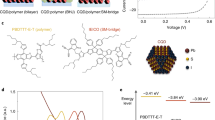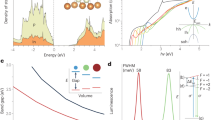Abstract
Tuning of the electronic bandgap in colloidal quantum dots (CQDs) by changing their size enables the spectral response of CQD-based photodetectors1,2,3,4,5 and photovoltaic6,7,8,9,10,11,12 devices to be tailored. Multi-junction solar cells made from a combination of CQDs of differing sizes and thus bandgaps are a promising means by which to increase the energy harvested from the Sun's broad spectrum. Here, we report the first CQD tandem solar cells using the size-effect tuning of a single CQD material, PbS. We use a graded recombination layer to provide a progression of work functions from the hole-accepting electrode in the bottom cell to the electron-accepting electrode in the top cell, allowing matched electron and hole currents to meet and recombine. Our tandem solar cell has an open-circuit voltage of 1.06 V, equal to the sum of the two constituent single-junction devices, and a solar power conversion efficiency of up to 4.2%.
This is a preview of subscription content, access via your institution
Access options
Subscribe to this journal
Receive 12 print issues and online access
$209.00 per year
only $17.42 per issue
Buy this article
- Purchase on SpringerLink
- Instant access to full article PDF
Prices may be subject to local taxes which are calculated during checkout




Similar content being viewed by others
References
Konstantatos, G. et al. Ultrasensitive solution-cast quantum dot photodetectors. Nature 442, 180–183 (2006).
Konstantatos, G., Clifford, J., Levina, L. & Sargent, E. H. Sensitive solution-processed visible-wavelength photodetectors. Nature Photon. 1, 531–534 (2007).
Clifford, J. P. et al. Fast, sensitive and spectrally tuneable colloidal-quantum-dot photodetectors. Nature Nanotech. 4, 40–44 (2009).
Rauch, T. et al. Near-infrared imaging with quantum-dot-sensitized organic photodiodes. Nature Photon. 3, 332–336 (2009).
Sukhovatkin, V., Hinds, S., Brzozowski, L. & Sargent, E. H. Colloidal quantum-dot photodetectors exploiting multiexciton generation. Science 324, 1542–1544 (2009).
Sargent, E. H. Infrared photovoltaics made by solution processing. Nature Photon. 3, 325–331 (2009).
Gur, I., Fromer, N. A., Geier, M. L. & Alivisatos, A. P. Air-stable all-inorganic nanocrystal solar cells processed from solution. Science 31, 462–465 (2005).
Kamat, P. V. Quantum dot solar cells semiconductor nanocrystals as light harvesters. J. Phys. Chem. C 112, 18737–18753 (2008).
Luther, J. M. et al. Schottky solar cells based on colloidal nanocrystal films. Nano Lett. 8, 3488–3492 (2008).
Arango, A. C., Oertel, D. C., Xu, Y., Bawendi, M. G. & Bulovic, V. Heterojunction photovoltaics using printed Colloidal Quantum Dots as a photosensitive layer. Nano Lett. 9, 860–863 (2009).
Koleilat, G. I. et al. Efficient, stable infrared photovoltaics based on solution-cast colloidal quantum dots. ACS Nano 2, 833–840 (2008).
Choi, J. J. et al. PbSe nanocrystal excitonic solar cells. Nano Lett. 9, 3749–3755 (2009).
McDonald, S. A. et al. Solution-processed PbS quantum dot infrared photodetectors and photovoltaics. Nature Mater. 4, 138–142 (2005).
Pattantyus-Abraham, A. G. et al. Depleted-heterojunction colloidal quantum dot solar cells. ACS Nano 4, 3374–3380 (2010).
Lamorte, M. F. & Abbott, D. H. Analysis of AlGaAs–GaInAs cascade solar cell under AM0–AM5 spectra. Solid-State Electron. 22, 467–473 (1979).
Lemorte, M. F. & Abbott, D. H. Computer modeling of a two-junction, monolithic cascade solar cell. IEEE Trans. Electron. Dev. 27, 831–840 (1980).
Yamaguchi, M., Takamoto, T., Araki, K. & Ekins-Daukes, N. Multi-junction III–V solar cells: current status and future potential. Solar Energy 79, 78–85 (2005).
King, R. R. et al. 40% efficient metamorphic GaInP/GaInAs/Ge multijunction solar cell. Appl. Phys. Lett. 90, 183516 (2007).
Hiramoto, M., Suezaki, M. & Yokoyama, M. Effect of thin gold interstitial-layer on the photovoltaic properties of tandem organic solar cell. Chem. Lett. 19, 327–330 (1990).
Yakimov, A. & Forrest, S. R. High photovoltage multiple-heterojunction organic solar cells incorporating interfacial metallic nanoclusters. Appl. Phys. Lett. 80, 1667–1669 (2002).
Kim, J. Y. et al. Efficient tandem polymer solar cells fabricated by all-solution processing. Science 317, 222–225 (2007).
Sista, S. et al. Highly efficient tandem polymer photovoltaic cells. Adv. Mater. 22, 380–383 (2010).
Kroger, M. et al. Role of the deep-lying electronic states of MoO3 in the enhancement of hole-injection in organic thin films. Appl. Phys. Lett. 95, 012301 (2009).
Kurishima, K., Nakajima, H., Yamahata, S., Kobayashi, T. & Matsuoka, Y. Effects of a compositionally-graded InxGa1–xAs base in abrupt-emitter InP/InGaAs heterojunction biopolar transistors. Jpn J. Appl. Phys. 34, 1221–1227 (1995).
Chinn, S. R., Zory, P. S. & Reisinger, A. R. A model for GRIN-SCH-SQW diode lasers. IEEE J. Quantum Electron. 24, 2191–2214 (1998).
Acknowledgements
This publication is based in part on work supported by an award (no. KUS-11-009-21) made by King Abdullah University of Science and Technology (KAUST), by the Ontario Research Fund Research Excellent Program, by the Natural Sciences and Engineering Research Council (NSERC) of Canada, Angstrom Engineering and Innovative Technology. The authors would like to acknowledge the assistance of M. Greiner and A. Fischer for UPS/XPS measurements and discussions. X.W. was partially supported by an Ontario Post Doctoral Fellowship from the Ontario Ministry of Research and Innovation. G.I.K. was partially supported by NSERC. The electron microscopy described in Supplementary Section SI1 was performed at the Canadian Centre for Electron Microscopy, which is supported by NSERC and other government agencies.
Author information
Authors and Affiliations
Contributions
X.W. and G.I.K. performed all device fabrication and characterization. L.L. assisted in CQD preparation. J.T., H.L., I.J.K., R.D., L.B., D.A.R.B. and S.H. assisted in GRL characterization and data analysis. X.W., G.I.K. and E.H.S. designed the experiments, interpreted the results and wrote the manuscript.
Corresponding author
Ethics declarations
Competing interests
The authors declare no competing financial interests.
Supplementary information
Supplementary information
Supplementary information (PDF 1012 kb)
Rights and permissions
About this article
Cite this article
Wang, X., Koleilat, G., Tang, J. et al. Tandem colloidal quantum dot solar cells employing a graded recombination layer. Nature Photon 5, 480–484 (2011). https://doi.org/10.1038/nphoton.2011.123
Received:
Accepted:
Published:
Issue Date:
DOI: https://doi.org/10.1038/nphoton.2011.123
This article is cited by
-
Recent Advancements in Photoelectrochemical Water Splitting for Hydrogen Production
Electrochemical Energy Reviews (2023)
-
Boosting Power Conversion Efficiency of Quantum Dot-Sensitized Solar Cells by Integrating Concentrating Photovoltaic Concept with Double Photoanodes
Nanoscale Research Letters (2020)
-
Improving the power conversion efficiency of perovskite solar cells by adding carbon quantum dots
Journal of Materials Science (2020)
-
Performance Enhancement of CdS/CdSe Quantum Dot-Sensitized Solar Cells with (001)-Oriented Anatase TiO2 Nanosheets Photoanode
Nanoscale Research Letters (2019)
-
Dual-band infrared imaging using stacked colloidal quantum dot photodiodes
Nature Photonics (2019)



